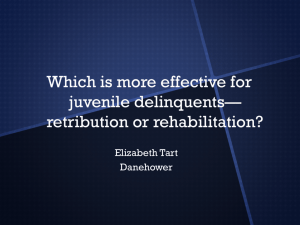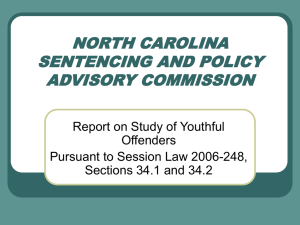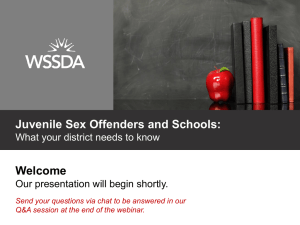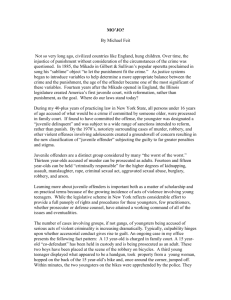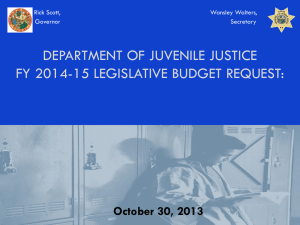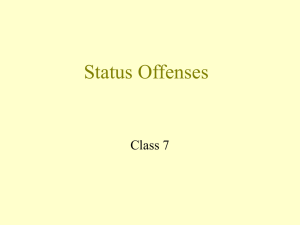Youthful Offender Block Grant: First Year Outcomes
advertisement
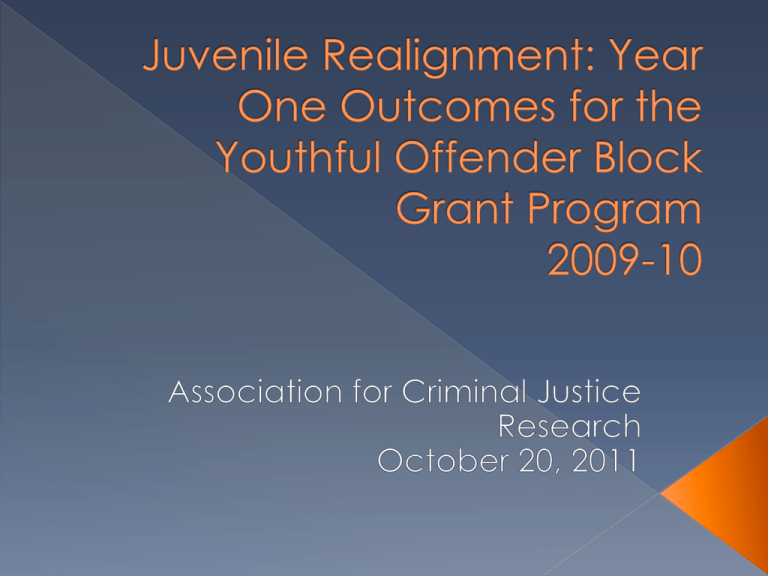
The Youthful Offender Block Grant (YOBG) Program was established through enactment of Senate Bill 81 in 2007. Under YOBG, non-serious, non-violent, nonsex offender juveniles are no longer eligible for commitment to the Division of Juvenile Justice (DJJ). Instead, counties receive State funding to supervise and treat these offenders. The original goals of SB 81 were to: › reduce the size of DJJ › save the state money › keep non-violent offenders closer to home In 2009, YOBG underwent significant changes as a result of SBX 4 13 (2009), including: › Annual county reporting of proposed and actual expenditures. › Annual county reporting of performance outcomes on certain youth. › Annual Legislative report by CSA summarizing county expenditures and outcomes. Although originally funded from the State General Fund, under the Public Safety Realignment Act of 2011, YOBG is now funded with state sales tax. The annual amount is no longer specified in law; however, it is still anticipated to be $93 million. YOBG is a formula grant that takes into consideration each county’s juvenile population and the number of juvenile felony dispositions. YOBG provides an incredibly flexible funding stream, allowing almost any expenditure related to juvenile justice. Unlike most state funding sources, YOBG does not prohibit supplantation of funds. The Youthful Offender Block Grant provides financial support to counties while affording maximum flexibility in what and how services are delivered. Given that flexibility, counties have opted to utilize a wide variety of programs, placements and other approaches to providing supervision and rehabilitation to youthful offenders. During 2009-10, $86.6 million was spent. YOBG funds supported 225 programs that supported over 38,000 youth. Capacity Building/ Maintenance Activities 3% Direct Services 24% Placements 73% Community Based Organizations 3% Fixed Assets/ Equipment 1% Administrative Overhead 1% Other Costs 3% Professional Services 8% Services & Supplies 9% Salaries & Benefits 75% DOJ randomly selected 1,100 cases from the Juvenile Court & Probation Statistical System that met the following criteria: Felony adjudicated youth only, no misdemeanants Adjudication dates during fiscal year 2008-09 (later modified to 9/1/07-6/30/09) The number of cases per county was proportionate to YOBG allocation amounts Gender and ethnicity of the sample was representative of the overall population Of the 1,011 sample youth, 334 received YOBGfunded services, including: Risk/Needs Assessment – 92% (vs. 80% for other 677 youth) Development of Case Plan – 88% (vs. 74%) Supervision in a Juvenile Hall – 74% (vs. 65%) Intensive Probation Supervision – 61% (vs. 32%) Alcohol & Drug Treatment – 57% (vs. 36%) Aggression Replacement Therapy – 25% (vs. 7%) Re-Entry/Aftercare – 25% (vs. 23%) Of the 334 youth who received YOBG-funded services, the outcomes below were reported for the one-year period following date of disposition: 95% were enrolled in school during the year (vs. 90%) 12% graduated from high school or earned a GED (vs. 8%) 20% were adjudicated in juvenile court for a new felony (vs. 12%) 2% were convicted in adult court for a new felony (vs. 6%) Based on the data collected, it appears the infusion of YOBG funds into county juvenile justice has resulted in: More services More assessments An opportunity for better outcomes


